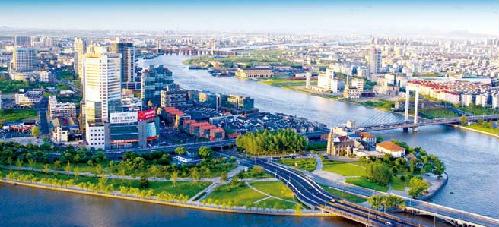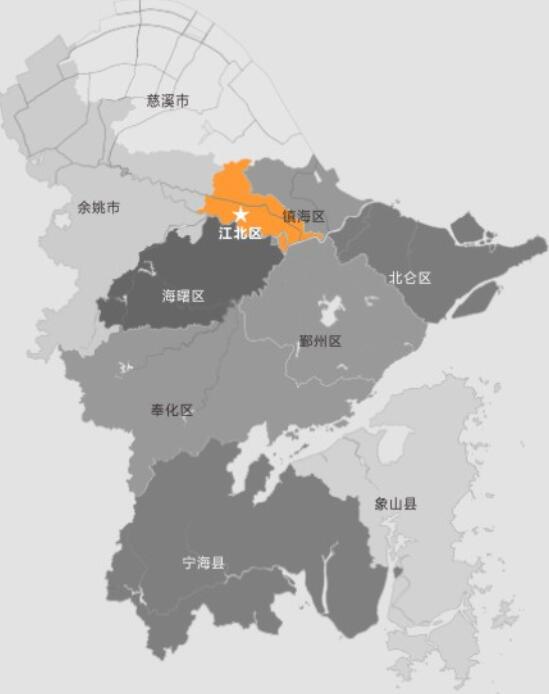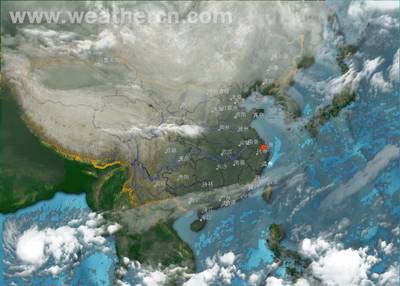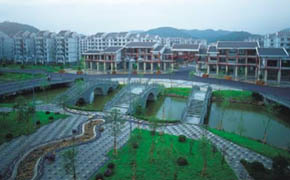General Status

Jiangbei District, where the “Three Rivers” in Ningbo run through, is located in the Northwest of the urban area in Ningbo. It boasts its unique geographical advantages, profound culture of a long history, charming landscape and abundant tourism resources. Jiangbei is the kernel area of the “Urban Tourism Circle and Three-river Charming Tourism Belt” in Ningbo..

Jiangbei District, with Yong River on its Southeast side and Yaojiang River on its South side, is adjacent to Haishu District and Yinzhou District. To its Northeast, there is Zhenhai District and to the West, there is the city of Yuyao. Jiangbei District, covering a total area of 208 square kilometers, is about 27 kilometers long from its East to the West and around 20 kilometers from its South to the North. Jiangbei (literally means “in the north of the river”) is named after the fact that major area of the district is located in the North of Yong River and Yaojiang River.
The total realm of Jiangbei district is round 208.73 square kilometers with about 27 km long from East to West and about 20 km wide from North to South. The total registered population of Jiangbei district is more than 240,000. The four urban area blocks includes Zhongma, Baisha, Kongpu, and Wenjiao. The four rural under area blocks are Yongjiang, Zhuangqiao, Hongtang, and Cicheng. Jiangbei district was nominated as an experiment unit of ‘Ningbo Urban and Rural Integration Reform’ last year.

Jiangbei district has rich beaches, rivers, lakes, and mountain landscapes.
Jiangbei district has rich beaches, rivers, lakes, and mountain landscapes. Outside the district is the Yaojing river, and inside the district there are Sun lake, Sun lake, and Hero reservoir. The total water area, mountain area and farmland area of the district are 60,000 mus, 40,000 mus, and 90,000 mus respectively. It has the mountain and water area that are closest to the city centre, and is therefore suitable for the establishment of a livable place. As a district with a long history and culture, it retains in perfect status a series of ancient cultural relics and ancient buildings.
Climatic Environment
Ningbo is humid monsoon climate region of north semitropical zone, which is characterized in mild and humid climate, distinct season division, abundant rainfalls and obvious alteration of the winter and summer monsoon. The four seasons of Ningbo is featured in that winter and summer are long (each is about 4 months), and spring and autumn are short (each is about 2 months). If the seasons are divided according to the standard that the average temperature that is equal to 10~22℃ is spring and autumn, that is more than 22℃ is summer and that is less than 10℃ is winter, Ningbo enters spring in March, summer in June, autumn in September and winter in November. But in the west mountainous area, winter is 1 month longer than that of plain, summer is 2 months shorter, and spring and autumn are ten days longer, so climate of the mountainous area features that spring comes late and autumn goes early.

The various climate resources of Ningbo offer the favorable conditions for developing mixing farming. The annually average temperature of Ningbo is 16.3℃ and the extreme highest temperature is 39.℃, July is the hottest and January is the coldest, the period of high temperature of the north part is longer than that of south part, and the period of high temperature of inland is longer that of coastal area; the extreme lowest temperature is -11.1℃, but the days with lower temperature are few, the first day of the period when temperature is beyond10℃ stably is at the end of March and the last day is in late November, the period lasts for 237 days, and the accumulated temperature is 5100℃, the accumulated temperature of mountainous area is 1000℃ less than that of plain.
The annually average rainfall is about 1400mm, and the rainfall of hilly area is 30% more than that of the plain area, the rainy season is from March to June (namely spring rains joining the plum rains and the raining days of the month are more than 15 days) and from August to September (namely typhoon rains and fall rains). Ningbo often enters the plum rain season in mid- June, wherein, the earliest time that Ningbo entered the plum rains season in the history was the latter mid-May and the latest was at the end of June; the plum season of Ningbo is over at the end of early – July, the earliest was in the middle of June and the latest was in the early August. Ningbo belongs to the humid and semi humid area, namely the income and expenses (Precipitation and Evaporation) are basic balance, and as for the area distribution, the north is drier than the south.
The time of annually sunlight is more than 1900 hours. Due the zone span is about 1.5 latitude, and as for the area distribution, the sunlight hours of the north part are more than the south; and because the mountainous area of the west part has more clouds, so the sunshine hours are 1.10 less than that of the plain.
The typhoon that affects Ningbo mainly occurs during the period from July to September (process rainfall >=50 mm or wind speed>=17m/s).
The days having rainstorm (rainfall of per day is more than 50mm) is 2~5 days annually which mainly occur in the plum rains season from June to early July and typhoon storms from August to September, wherein, that of September is more.
 Drought usually occurs in the period from June to September, hilly areas of Ninghai and Xiangshan and Cixi whose use ratio of precipitation is lower have more frequency, in which draught occurs one time in 2~3 years while in other area draught occurs one time in4~5 years.
Drought usually occurs in the period from June to September, hilly areas of Ninghai and Xiangshan and Cixi whose use ratio of precipitation is lower have more frequency, in which draught occurs one time in 2~3 years while in other area draught occurs one time in4~5 years.
The low-temperature and overcast is cold weather in late spring and the low temperature of spring and autumn. Late spring coldness is that, after Pure Bright Festival (5th April ), the daily average temperature is <=11℃ and the atmosphere lasts for three days or more, Ningbo generally occurs once in 2~3 years and most of the times is in the second climate and third climate of April; The overcast and rain in spring is that the overcast and rain lasts for 4days or more during the period from late March to the end of April (rainfall >=0.0mm and sunshine hour <2 hours). It occurs average 1.1 times annually. The low-temperature of autumn is the course that daily average temperature<=20℃ or 22℃ lasts for three continuous days in mid and late September, which leads that the in-the-milk and ripe courses of rice and cross-fertilized late rice are slow so as to cause the reduction of output of rice, and the low-temperature of autumn occurs once in 4 years but the distribution is not even, some times the low-temperature of autumn will occurs consistently and sometimes it only occurs once in 8~9 years. The frost can be divided into early and late frost. The first frost of Ningbo is generally in the middle of November and the last frost is at the end of March and beginning of April. The period of snow is generally from late November to early March of the next year, which lasts 1~2 months. The average snow time is 6~10 days and the average accumulating snow period is 2~6 days. The thunderstorm occurs in the period from March to October with annually average time of 30~47 days, the first thunderstorm is in early March and the earliest was in late February; the last thunderstorm is in mid October, the latest was in early December.
Inhabited Environment
There are many colleges in the area, including Ningbo
University, Ningbo Science & Technology College ,Ningbo Broadcasting University,Ningbo Mechanical College,Ningbo Textile Vocational College.There are also several hospital such as Ningbo No.2 Hospital,Ningbo No.3 Hospital,the Attached Hospital of Medical Department of Ningbo University,Tongyuhan Medical Center,Jiangbei People’ Hospital,Kangning Hospital,Baoli Hospital.In recent years,a number of luxury apartments have also been built to meet people’s needs such as Beian Residential Area,Tianshui Residential Area,Jinjiang Residential Area,Qinglinwan Residential Area.